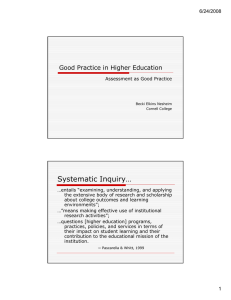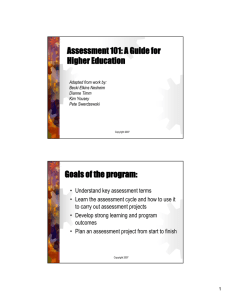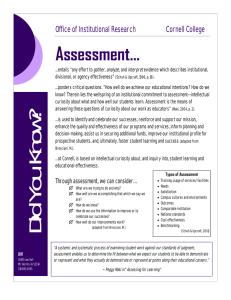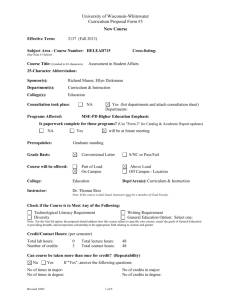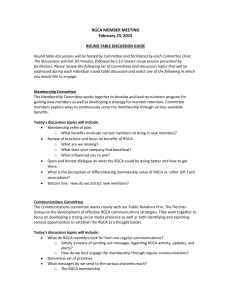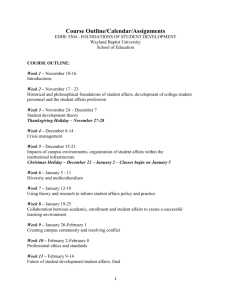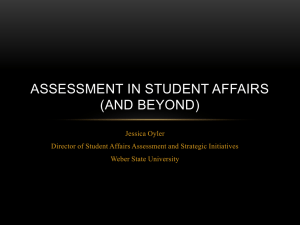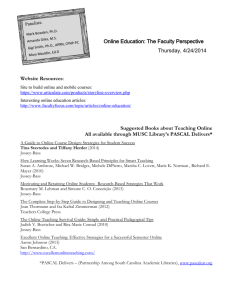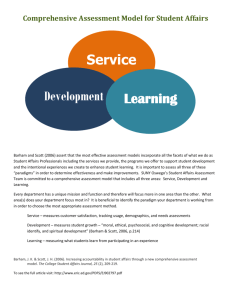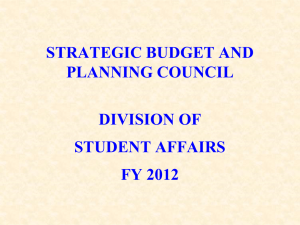Assessment Glossary
advertisement
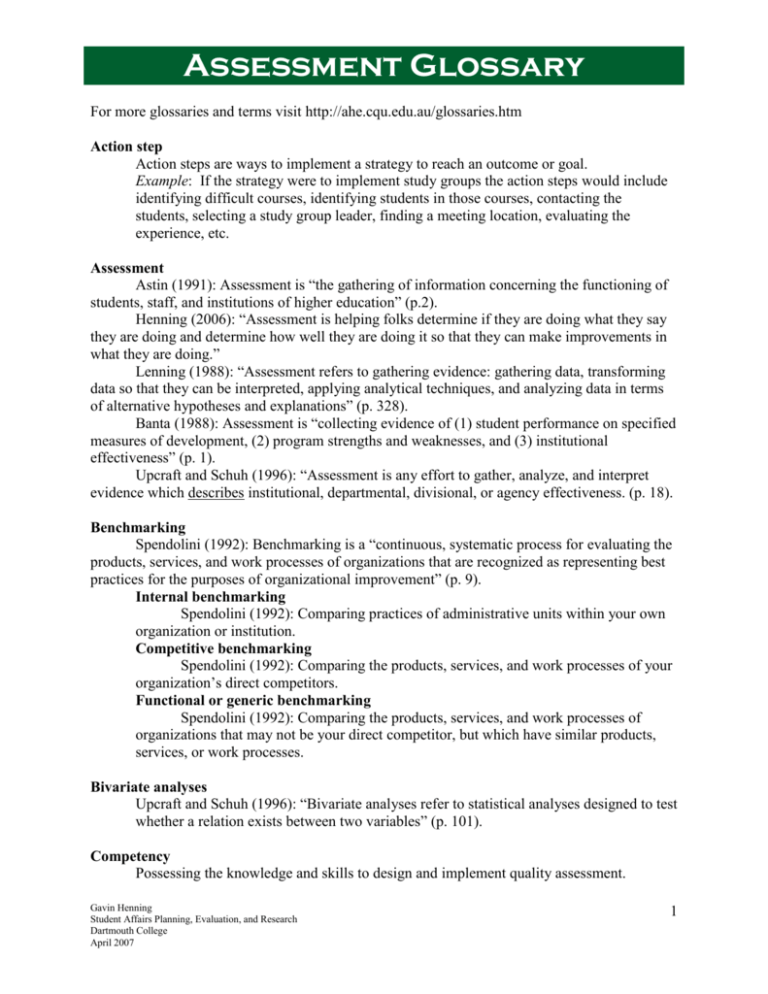
Assessment Glossary For more glossaries and terms visit http://ahe.cqu.edu.au/glossaries.htm Action step Action steps are ways to implement a strategy to reach an outcome or goal. Example: If the strategy were to implement study groups the action steps would include identifying difficult courses, identifying students in those courses, contacting the students, selecting a study group leader, finding a meeting location, evaluating the experience, etc. Assessment Astin (1991): Assessment is “the gathering of information concerning the functioning of students, staff, and institutions of higher education” (p.2). Henning (2006): “Assessment is helping folks determine if they are doing what they say they are doing and determine how well they are doing it so that they can make improvements in what they are doing.” Lenning (1988): “Assessment refers to gathering evidence: gathering data, transforming data so that they can be interpreted, applying analytical techniques, and analyzing data in terms of alternative hypotheses and explanations” (p. 328). Banta (1988): Assessment is “collecting evidence of (1) student performance on specified measures of development, (2) program strengths and weaknesses, and (3) institutional effectiveness” (p. 1). Upcraft and Schuh (1996): “Assessment is any effort to gather, analyze, and interpret evidence which describes institutional, departmental, divisional, or agency effectiveness. (p. 18). Benchmarking Spendolini (1992): Benchmarking is a “continuous, systematic process for evaluating the products, services, and work processes of organizations that are recognized as representing best practices for the purposes of organizational improvement” (p. 9). Internal benchmarking Spendolini (1992): Comparing practices of administrative units within your own organization or institution. Competitive benchmarking Spendolini (1992): Comparing the products, services, and work processes of your organization’s direct competitors. Functional or generic benchmarking Spendolini (1992): Comparing the products, services, and work processes of organizations that may not be your direct competitor, but which have similar products, services, or work processes. Bivariate analyses Upcraft and Schuh (1996): “Bivariate analyses refer to statistical analyses designed to test whether a relation exists between two variables” (p. 101). Competency Possessing the knowledge and skills to design and implement quality assessment. Gavin Henning Student Affairs Planning, Evaluation, and Research Dartmouth College April 2007 1 Ethics Winston and Saunders (1991): Ethics is concerned with determining what acts or behaviors are ‘right,’ or ‘ought to be done/not done’ as well as determining the epistemological justifications for ethical statements or assertions” (p. 311). Evaluation Astin (1991): Evaluation is the utilization of information for institutional and individual improvement. Evaluation…has to do with motivation and the rendering of value judgments (p. 2). Upcraft and Schuh (1996): “Evaluation is any effort to use assessment evidence to improve institutional, departmental, divisional, or agency effectiveness” (p. 19). Formative evaluation Upcraft and Schuh (1996): “Formative evaluations are those used to improve organizational or institutional effectiveness. Formative evaluations typically focus on improving the processes which potentially lead to increased effectiveness” (p. 19). Summative evaluation Upcraft and Schuh (1996): “Summative evaluations are used to determine if a particular organizational activity or function should be continued, enhanced, curtailed, or eliminated. In other words, summative evaluations are conducted for purposes of accountability and strategic planning” (p. 19). Political evaluation Brown and Podolske (1993): Political evaluation is evaluation that is used to communicate and defend student affairs to potential stakeholders, including professional staff, office staff, faculty, administrators, parents, taxpayers, and funders. Goal A goal is an end result written in broad terms. Example: As a result of participating in the Pathways to Success Program students will increase their academic achievement. Here, academic achievement is a broad term. Mission statement Bryson (2004): A mission clarifies an organization’s purpose, or why it should be doing what it does. (p. 102) Multivariate analysis Upcraft and Schuh (1996): “Multivariate analyses allow for studying the relationship of several responses to one response or outcome” (p. 106). Needs assessment Rossett (1990): Needs assessment is “the careful study of the context, job, skills, knowledge and job incumbents to implementing an intervention” (p. 191). Stufflebeam, McCormick, Brinkerhoff, and Nelson (1985): Needs assessment is “the process of determining the things that are necessary or useful for the fulfillment of a defensible purpose” (p. 16). Gavin Henning Student Affairs Planning, Evaluation, and Research Dartmouth College April 2007 2 Objective An objective is the intended effect of a service or intervention, but is much more specific than goals. It is facilitator centered. Example: The Pathways to Success Program will help students increase their first year grade point average. Compare to the similar goal statement, grade point average is a more specific outcome compared to academic achievement. Outcome An outcome is the desired effect of a service or intervention, but is much more specific than goals. These are often what students should be able to demonstrate after their participation, which are also defined as learning or developmental outcomes. Outcomes can also be programmatic. A programmatic outcome could be something like an increase in usage of a particular resource or service. It is participant focused. Example: As a result of participating in the Pathways to Success Program students will increase their first year grade point average. Compare to the similar goal statement, grade point average is a more specific outcome compared to academic achievement. Proficiency Possessing a specified amount of knowledge or skills to design and implement quality assessment. Qualitative methodology Patton (1990): The detailed description of situations, events, people, interactions, and observed behaviors; the use of direct quotations from people about their experiences, attitudes, beliefs, and thoughts; and the analysis of excerpts or entire passages from documents, correspondence, records, and case histories. Quantitative methodology Rossman and El-Khawas (1987): The assignment of numbers to objects, events, or observations according to some rule. Research The collection and analysis of data to build or confirm theory and conceptual foundations. Strategic planning Bryson (1995): Strategic planning is a “disciplined effort to produce fundamental decisions and actions that shape and guide what an organization is, what it does, and why it does it” (pp. 4-5). Strategy A strategy is means to achieving outcomes or goals. Example: In order to increase students’ GPA we will develop and implement weekly study groups with trained facilitators in the traditionally difficult courses. Vision statement Bryson (2004): A vision clarifies what the organization should look like and how it should behave as it fulfills its mission (p. 102). Gavin Henning Student Affairs Planning, Evaluation, and Research Dartmouth College April 2007 3 REFERENCES Astin, A. W. (1991). Assessment for excellence. New York: Macmillan. Banta, T. W. (Ed). (1988). Implementing outcomes assessment: Promises and perils. New Directions for Institutional Research, no. 59. San Francisco: Jossey-Bass, 1988. Brown, R. D., and Podolske, D. L. (1993). A political model for program evaluation. In M. J. Barr and Associates, A handbook for student affairs administration. San Francisco: Jossey-Bass. Bryson, J. M. (1995). Strategic planning for public and nonprofit organizations: A guide to strengthening and sustaining organizational achievement. San Francisco: Jossey-Bass. Lenning, O. T. (1988). Use of noncognitive measures in assessment. In T. W. Banta (Ed.), Implementing outcomes assessment: Promises and perils. New Directions for Institutional Research, no. 59. San Francisco: Jossey-Bass. Patton, M. Q. (1990). Qualitative evaluation and research methods (2nd ed.). Newbury Park, CA: Sage. Rossman, , J. E., and El-Khawas, E. (1987). Thinking about assessment: Perspectives for presidents and chief academic officers. Washington, D.C.: American Council on Education and American Association for Higher Education. Rossett, A. (1990). Needs assessment: Forerunner to successful HRD programs. In J. W. Pfeiffer (Ed.), The 1990 annual: Developing human resources. San Diego: University Associates. Speldoni, M. J. (1992). The benchmarking book. New York: American Management Association. Stufflebeam, D. L., McCormick, C. H., Brinkerhoff, R. O., and Nelson, C. O. (1985). Conducting educational needs assessment. Norwell, MA: Wolters Kluwer. Upcraft, M. L. and Schuh, J. H. (1996). Assessment in student affairs: A guide for practitioners. San Francisco: Jossey-Bass. Winston, R. B., Jr., and Saunders, S. A. (1991). Ethical professional practice in student affairs. In T. K. Miller and R. B. Winston, Jr. (Ed.), Administration and Leadership in Student Affairs. Muncie, ID: Accelerated Development. Gavin Henning Student Affairs Planning, Evaluation, and Research Dartmouth College April 2007 4
